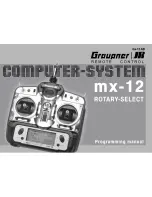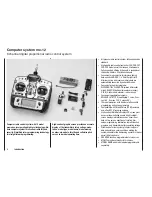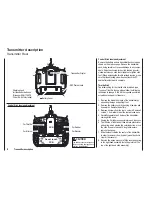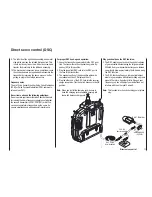
Safety notes
Please read carefully!
Safety notes
3
We all want you to have many hours of pleasure in our
mutual hobby of modelling, and safety is an important
aspect of this. It is absolutely essential that you read
right through these instructions and take careful note of
all our safety recommendations. If you are a beginner to
the world of radio-controlled model aircraft, boats and
cars, we strongly advise that you seek out an experi-
enced modeller in your field and ask him for help and
advice. These instructions must be handed on to the
new owner if you ever sell the transmitter.
Application
This radio control system may only be used for the
purpose for which the manufacturer designed it, i.e. for
operating radio-controlled models which do not carry hu-
mans. No other type of use is approved or permissible.
Safety notes
SAFETY IS NO ACCIDENT
and …
RADIO-CONTROLLED MODELS ARE NOT
PLAYTHINGS
Even small models can cause serious personal injury
and damage to property if they are handled incompe-
tently.
Technical problems in electrical and mechanical systems
can cause motors to rev up or burst into life unexpected-
ly, with the result that parts may fly off at great speed,
causing considerable injury.
Short-circuits of all kinds must be avoided at all times.
Short-circuits can easily destroy parts of the radio cont-
rol system, but even more dangerous is the acute risk of
fire and explosion, depending on the circumstances and
the energy content of the batteries.
The circumstances and the energy content of the
batteries.
Aircraft and boat propellers, helicopter rotors, open
gearboxes and all other rotating parts which are driven
by a motor or engine represent a constant injury hazard.
Do not touch these items with any object or part of your
body.
Remember that a propeller spinning at high
speed can easily slice off a finger!
Ensure that no
other object can make contact with the driven compon-
ents.
Protect all electronic equipment from dust, dirt, damp,
and foreign bodies. Avoid subjecting the equipment
to vibration and excessive heat or cold. Radio control
equipment should only be used in „normal“ ambient tem-
peratures, i.e. within the range -15°C to +55°C. Avoid
subjecting the equipment to shock and pressure.
Check the units at regular intervals for damage to cases
and leads. Do not re-use any item which is damaged
or has become wet, even after you have dried it out
thoroughly. Use only those components and accessories
which we expressly recommend. Be sure to use only
genuine matching GRAUPNER connectors of the same
design with contacts of the same material. Use only
genuine GRAUPNER plug-in crystals on the appro-
priate frequency band. When deploying cables note
that they must not be under tension, and should never
be bent tightly or kinked, otherwise they may fracture.
Avoid sharp edges which could wear through the cable
insulation.
Check that all connectors are pushed home firmly
before using the system. When disconnecting compo-
nents, pull on the connectors themselves - not on the
wires.
It is not permissible to carry out any modifications to
the RC system components. Avoid reverse polarity
and short-circuits of all kinds, as the equipment is not
protected against such errors.
Installing the receiving system and deploying the
receiver aerial
In a model aircraft the receiver must be packed in soft
foam and stowed behind a stout bulkhead, and in a
model boat or car should be protected effectively from
dust and spray.
The receiver must not make contact with the fuselage,
hull or chassis at any point, otherwise motor vibration
and landing shocks will be transmitted directly to it.
When installing the receiving system in a model with a
glowplug or petrol engine, be sure to install all the com-
ponents in well protected positions so that no exhaust
gas or oil residues can reach the units and get inside
them. This applies above all to the ON / OFF switch,
which is usually installed in the outer skin of the model.
Secure the receiver in such a way that the aerial, servo
leads and switch harness are not under any strain.
The receiver aerial is permanently attached to the recei-
ver. It is about 100 cm long and must not be shortened
or extended. The aerial should be routed as far away
as possible from electric motors, servos, metal push-
rods and high-current cables. However, it is best not to
deploy the aerial in an exactly straight line, but to angle
it: e.g. run it straight to the tailplane, then leave the final
10 - 15 cm trailing down, as this avoids reception „blind
spots“ when the model is in the air. If this is not possible
we recommend that you lay out part of the aerial wire
in an S-shape inside the model, close to the receiver if
possible.




































